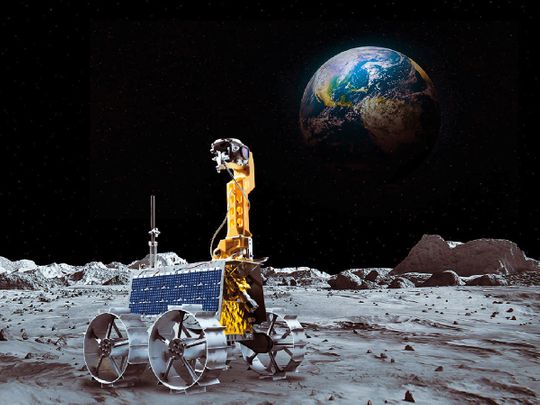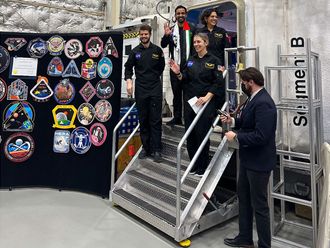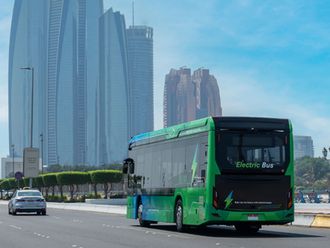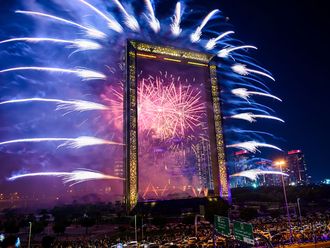
Dubai: All eyes will be on the Moon tomorrow as the UAE’s Rashid Rover, the first lunar spacecraft built by an Arab country, is all set to attempt landing on the lunar surface on April 25.
The Emirati-built rover, once landed, will explore the characteristics of lunar soil, the petrography and geology of the Moon, dust movement, surface plasma conditions, and the Moon’s photoelectron sheath.
The ambitious feat will make the UAE the first Arab country and only the fourth country in the world to land on the Moon — after the United States, the former Soviet Union and China. The success rate is fifty percent.
Bigger determination
Salem Humaid Al Marri, director general of Mohammed Bin Rashid Space Centre (MBRSC) in Dubai, the agency behind the Emirates Lunar Mission (ELM), the UAE Astronaut Programme and the Emirates Mars Mission (EMM), on Monday took the opportunity to thank the teams behind the milestone space programmes.
“We start a historic week for the Emirati and Arab space sector. Tomorrow, the 1st Arab mission to the Moon is set to landing with a success rate of 50%. On 28 April, @Astro_Alneyadi will conduct the 1st Arab spacewalk ever. The challenges are big. Our determination is bigger,” Al Marri said in a tweet.
He was referring to the spacewalk by the UAE astronaut Sultan Al Neyadi, who is on the longest Arab space mission on the International Space Station.
“Thank you to the teams of the Emirates Lunar Mission and UAE Astronaut Programme, who are working 24/7 in collaboration with partners to make the missions a success,” Al Marri added.
Sultan’s wish from space
Meanwhile, Al Neyadi sent his best wishes to the colleagues at MBRSC from space.
Taking to social media, the ‘Sultan of Space’ said that everyone was eagerly anticipating the landing of Rashid Rover on the Moon as part of the first Emirati and Arab lunar mission
“While the success rate for such missions has not exceeded 50%, we are confident in our team at MBRSC. I wish them all the best for this historic voyage,” he added.
Biggest challenge, key moment
MBRSC also released a video of engineer Abdulla Al Shehhi, who is the Rover Mechanical Engineering Lead of the ELM, speaking about the mission. His role was to oversee the structural design and the mobility subsystems in the rover.
In the video, Al Shehhi said developing the mobility subsystem with limited mass was one of the biggest challenges faced during the preparation for the mission.
“We overcame it through conducting several experiments,” he said.
The key moment of the mission that is anticipated is the landing of the rover on the surface of the Moon and capturing the first image, he said.
Summarising the mission in one word, Al Shehhi said: “The beginning.”
A core team of 11 from MBRSC including Al Shehhi is behind the mission’s development. They had been working on building the four-wheel rover weighing only 10kg since 2017.
Just the beginning
As space engineer Al Shehhi put it, the moon landing will only be the beginning of the UAE’s long-term Emirates Lunar Mission (ELM) which will pave the way to accomplish the UAE’s mission of sending humans to Mars by 2117 (EMM).
The landing attempt comes well ahead of the initially planned touchdown on the lunar surface. When His Highness Sheikh Mohammed bin Rashid Al Maktoum, Vice-President and Prime Minister of the UAE and Ruler of Dubai first announced about the Rashid Rover named after his father and former Dubai Ruler the late Sheikh Rashid bin Saeed Al Maktoum in September 2020, the rover was planned to land on the surface of the moon only by 2024.
On December 11, 2022, HAKUTO-R Mission 1 Lunar Lander (HAKUTO-R M1), the Japanese lander carrying the Rashid Rover, was launched on a SpaceX Falcon 9 rocket from Cape Canaveral Space Force Station, Florida, US, beginning a journey that look the lander approximately 1.4million km into deep space and into the lunar orbit.
A lander is a spacecraft that can touch down on a planetary surface. It is equipped with a propulsion and navigation system, allowing it to power through space and land safely with its cargo.
Landing time
According to ispace, the Japanese company behind the lander, the earliest targeted landing time is 16:40 UTC i.e. 8.40pm GST tomorrow.
The lander is scheduled to begin the landing sequence from the 100 km altitude orbit at approximately 15:40 UTC (7.40pm here).
“During the sequence, the lander will perform a braking burn, firing its main propulsion system to decelerate from orbit. Utilising a series of pre-set commands, the lander will adjust its altitude and reduce velocity in order to make a soft landing on the lunar surface. The process will take approximately one hour,” ispace said.
If the Lander with multiple payloads including the Rashid Rover successfully touches down on the Moon’s surface, it will become the first commercial lander to achieve that feat.
Should conditions change, there are three alternative landing sites and depending on the site, the landing date may change. Alternative landing dates, depending on the operational status, are April 26, May 1, and May 3, 2023.
Once it manages to soft-land on the lunar surface, it will set the Rashid Rover down on a ramp as the deployment, commissioning and drive-off command sessions will begin.
Landing site
The primary landing site is the Atlas crater, located at 47.5°N, 44.4°E, on the southeastern outer edge of Mare Frigoris (Sea of Cold). Mare Frigoris lies in the far lunar north. It was chosen to maintain flexibility during operations.
It was chosen along with multiple contingencies, which may be used depending on variables that occur during transit. The site meets the technical specifications of the lander technology demonstration mission and the scientific exploration objectives for the ELM mission.
The novel discovery within the unexplored lunar site is one of the many reasons why the Emirates Lunar Mission is one of the most anticipated moon missions.
Success 9, the next Mission 1 milestone, will be announced after a successful lunar landing is confirmed, ispace said. Success 10, the last of the Mission 1 milestones, will be announced after confirmation that a steady telecommunications and power supply have been established after landing on the Moon.
A live-streaming broadcast from Tokyo has been planned for the landing day on the YouTube channel of ispace. But given distance, time, etc, the company may only have a general idea of the outcome of the landing sequence initially.
What will the rover do?
One of the biggest challenges astronauts encounter on the Moon is lunar dust, often known as regolith.
Scientists discovered how lunar dust adhered to spacesuits, causing erosion and operational issues, during the Apollo missions.
The razor-sharp lunar dust particles that attach to almost everything will be a problem when space organisations send people back to the Moon.
With an experiment that will test several materials against the dust, the Rashid rover is made to deal with this issue.
A variety of test samples would be attached to the rover’s wheels for the material adhesive experiment.
The rover is also expected to send thousands of images to the mission control in MBRSC. For this, two cameras supplied by the French space agency would be used. While one camera is placed on top for panoramic images of the robot’s surroundings, the other one is a rear camera that would capture images as the lander throws up regolith behind it.
For 10-12 days, the Rashid rover will conduct continuous surface research and image capture, said MBRSC.
Rashid Rover in a nutshell
Rashid Rover is a 10kg, four-wheeled spacecraft that was built to explore the Moon’s surface.
It aims to study the geography of the lunar surface as well as lunar soil, or regolith.
It was built by the Emirati engineers at the Mohammed Bin Rashid Space Centre in Dubai.
It was named after the former Dubai Ruler, the late Sheikh Rashid bin Saeed Al Maktoum.
It was launched on HAKUTO-R Mission 1 Lunar Lander (HAKUTO-R M1).
Important dates
December 11, 2022—The lander built by Japanese company ispace was launched on a SpaceX Falcon 9 rocket from Cape Canaveral Space Force Station, Florida, US, carrying Rashid Rover and other payloads.
December 15, 2022 –The lander completed its first orbital control manoeuvre.
January 11, 2023—It completed one month of deep space travel.
January 20, 203—The lander reached the farthest point into space, approximately 1.4million km from Earth.
March 17, 2023—All deep space orbital control manoeuvres were completed.
March 21, 2023—The lander entered the Lunar Orbit.
April 13, 2023—It completed the final lunar orbital control manoeuvre.
April 25, 2023—The lander is attempting to land on the Moon’s surface.












